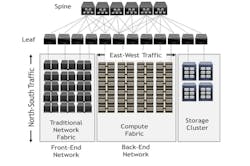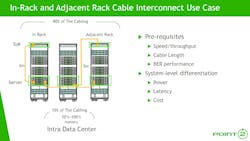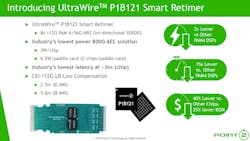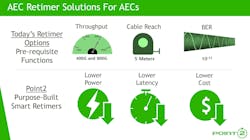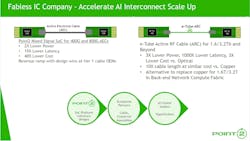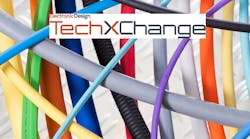112G Mixed-Signal Retimer Helps Deliver 800G Copper Connectivity
What you’ll learn:
- The difference between active electrical cables and active optical cables.
- How Point2 Technology’s P1B121 retimer differs from DSP-based retimers.
The cloud seems to demand as much bandwidth as possible to feed CPUs, GPUs, and artificial-intelligence (AI) accelerators (Fig. 1). 400G connections are the norm these days, and 800 G is where data-center management wants to be, but active optical cables (AOCs) can be pricey for connections within the rack or adjacent racks. AOC is useful for longer distances, and another alternative—passive direct-attached copper cables (DACs)—can’t handle the higher speeds.
I talked with David Kuo, AVP Product Marketing and Business Development at Point2 Technology, about the need for retimers at each end of 800-gigabit (800G) copper-based, active electrical cables (AECs) (watch the video above). AECs can address the majority of cabling at a lower cost than AOCs (Fig. 2), and they typically have lower latencies.
Point2 Technology’s P1B121 112G PAM4 Smart Retimer implements eight unidirectional SerDes channels (Fig. 3). The chip only needs 3 W of power. The smart clock-data-recovery (CDR) retimer also supports 56G non-return-to-zero (NRZ) data rates. A mixed-signal approach is utilized rather than the PAM4 DSP retimers that are similar to the those used for optical cabling.
The P1B121 employs a bit-error-rate (BER)-aware architecture. It also has a latency of only 3 ns that’s 15X to 20X better than DSP-based solutions (Fig. 4).
Other features of the new chip include transmit serializers with a programmable FIR filter and pre-emphasis plus programmable output swing, and deserializer receivers with a programmable continuous time linear equalizer (CTLE) and decision feedback equalizer (DFE) to mitigate Rx channel loss. The P1B121 has programmable low sensitivity and data sampler threshold levels.
Retimers and 1.6-Tb Cabling
PAM4 retimers like the P1B121 can be used in the next step up—1.6 Tb/s. The challenge is on the copper side. Reductions in cable length is one way to meet the requirements, but Point2 Technology’s tentative approach is a technology called e-Tube (Fig. 5).
The approach is being referred to as active RF cabling (ARC). It compares favorably with the alternative, AOCs. Cable construction is similar to Twinax, allowing cable vendors to take advantage of their expertise in this area. The cost is significantly lower than fiber, and latency is better by a factor of 1,000. Maximum cable length is increased, which could eliminate the need for fiber in the remaining 10% where it’s used now in the backend network.
>>Check out this TechXchange for similar articles and videos
About the Author
William G. Wong
Senior Content Director - Electronic Design and Microwaves & RF
I am Editor of Electronic Design focusing on embedded, software, and systems. As Senior Content Director, I also manage Microwaves & RF and I work with a great team of editors to provide engineers, programmers, developers and technical managers with interesting and useful articles and videos on a regular basis. Check out our free newsletters to see the latest content.
You can send press releases for new products for possible coverage on the website. I am also interested in receiving contributed articles for publishing on our website. Use our template and send to me along with a signed release form.
Check out my blog, AltEmbedded on Electronic Design, as well as his latest articles on this site that are listed below.
You can visit my social media via these links:
- AltEmbedded on Electronic Design
- Bill Wong on Facebook
- @AltEmbedded on Twitter
- Bill Wong on LinkedIn
I earned a Bachelor of Electrical Engineering at the Georgia Institute of Technology and a Masters in Computer Science from Rutgers University. I still do a bit of programming using everything from C and C++ to Rust and Ada/SPARK. I do a bit of PHP programming for Drupal websites. I have posted a few Drupal modules.
I still get a hand on software and electronic hardware. Some of this can be found on our Kit Close-Up video series. You can also see me on many of our TechXchange Talk videos. I am interested in a range of projects from robotics to artificial intelligence.
